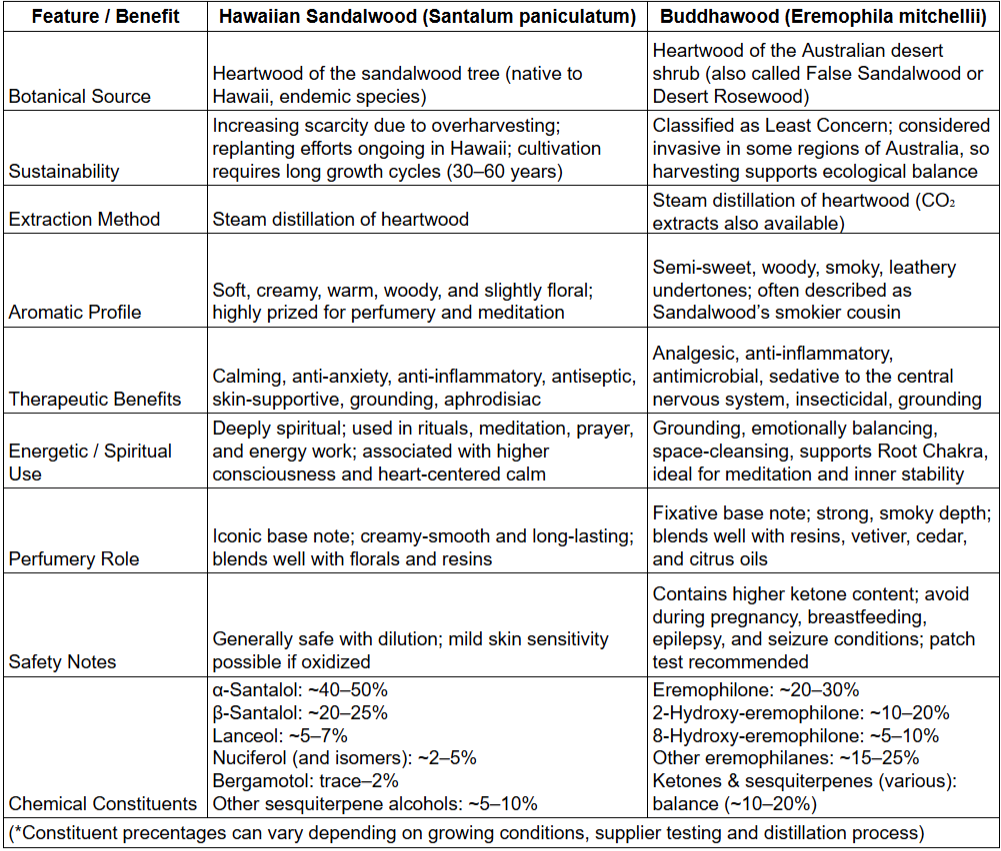Buddhawood: A Sustainable, Grounding Alternative to Sandalwood
As part of my holistic therapy practice, environmental protection and respect are guiding values. I am continually exploring ways to reduce my impact on the earth, including being more mindful of which essential oils I use and how they are sourced. Certain botanicals, such as Royal Hawaiian Sandalwood, are increasingly difficult to find and are accompanied by significant sustainability concerns. This awareness has inspired me to look for alternatives—leading me to discover a wood I was far less familiar with, but quickly grew curious about: Buddhawood.
From Curiosity to Discovery
At first glance, the name itself captured my attention as a Yoga Therapist—it resonated with themes of mindfulness and meditation. As I began researching, I noted aromatic and regional similarities to Australian Sandalwood, which only deepened my curiosity. What I uncovered is that Buddhawood is not only a fascinating aromatic in its own right but also one of the most highly recommended substitutes for Sandalwood, particularly Royal Hawaiian Sandalwood.
Aromatic Profile
Buddhawood shares certain olfactory qualities with Sandalwood but is often described as Sandalwood’s semi-sweet, smokier cousin. Its fragrance carries warm, woody and leathery undertones, making it a beautiful base note and fixative in aromatherapy blends. For those of us who love the grounding qualities of Sandalwood, Buddhawood offers a familiar yet distinct aromatic presence that complements meditation and relaxation practices.
Sustainability and Source
Buddhawood essential oil is steam-distilled from the heartwood of the Australian Desert Shrub (Eremophila mitchellii). Importantly, it is listed as a species of least concern on the IUCN Red List. In fact, Buddhawood is sometimes considered an invasive species in parts of Australia. This means that its thoughtful harvest for essential oil production may actually have a positive ecological impact, making it a rare example of an oil that is both aromatically valuable and environmentally responsible.
Therapeutic Properties
From a therapeutic perspective, Buddhawood is remarkably versatile. Documented actions include:
Analgesic – Supports relief of minor pain or discomfort.
Anti-inflammatory – Helps ease inflammation and swelling.
Antimicrobial – Offers natural defense against bacteria and microbes.
CNS Sedative – Promotes relaxation, calm, and nervous system balance.
Grounding – Helps steady the emotions and foster inner stability.
Insecticidal – Acts as a natural insect repellent.
Energetic & Spiritual Uses
Spiritually, Buddhawood has earned a reputation as a deeply grounding oil. It is often incorporated into meditation practices, used to cleanse and purify a space, and is believed to support the Root Chakra, fostering stability and presence. Clients and practitioners alike describe it as emotionally balancing and centering—qualities that make it an excellent addition to mindfulness and yoga therapy settings.
Safety Considerations
Although generally considered safe, Buddhawood contains a relatively high percentage of ketones. For this reason, it is best avoided during pregnancy and breastfeeding, as well as in individuals with neurological conditions such as epilepsy, history of seizures, or those with brain cancer. As always with essential oils, moderation, dilution, and awareness of individual sensitivities are key.
Closing Reflection
My exploration of Buddhawood has shown me that sustainability and holistic practice can walk hand in hand. It is an essential oil that not only honors the earth through its responsible use but also offers profound therapeutic and spiritual benefits. For those of us seeking grounding, emotional balance, and eco-conscious aromatherapy alternatives, Buddhawood may be the perfect ally.
In Hawaiian wisdom, there is a proverb that reminds us of this sacred reciprocity:
“E mālama i ka ʻāina, e mālama ʻia ana ka ʻāina iā ʻoe.”
Take care of the land, and the land will take care of you.
As we care for the earth by choosing oils and practices that respect its balance, we find that the land, in return, continues to nourish our bodies, minds, and spirits. Buddhawood offers a living example of this truth.
To learn more about Buddhawood and when it can be an appropriate substitute to Sandalwood, see the table and recommended readings and citations below.
Hawaiian Sandalwood vs. Buddhawood
Suggested Readings and Citations
Petersen, D. (2025, June 23). Buddha Wood: A closer look. American College of Healthcare Sciences. https://achs.edu/blog/buddha-wood-a-closer-look/#:~:text=This%20aromatic%20wood%2C%20with%20the,distinguish%20from%20the%20wood%20oil.
Rhind, J. (2020). Essential oils: A Comprehensive Handbook for Aromatic Therapy. Singing Dragon.
Sadgrove, N. J., Padilla-González, G. F., Green, A., Langat, M. K., Mas-Claret, E., Lyddiard, D., Klepp, J., Legendre, S. V., Greatrex, B. W., Jones, G. L., Ramli, I. M., Leuner, O., & Fernandez-Cusimamani, E. (2021). The diversity of volatile compounds in Australia’s semi-desert genus Eremophila (Scrophulariaceae). Plants, 10(4), 785. https://doi.org/10.3390/plants10040785


